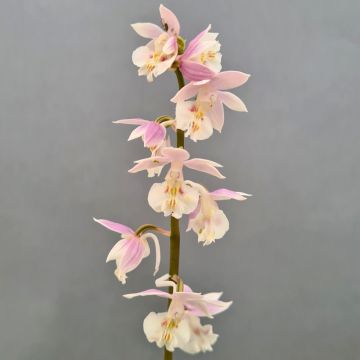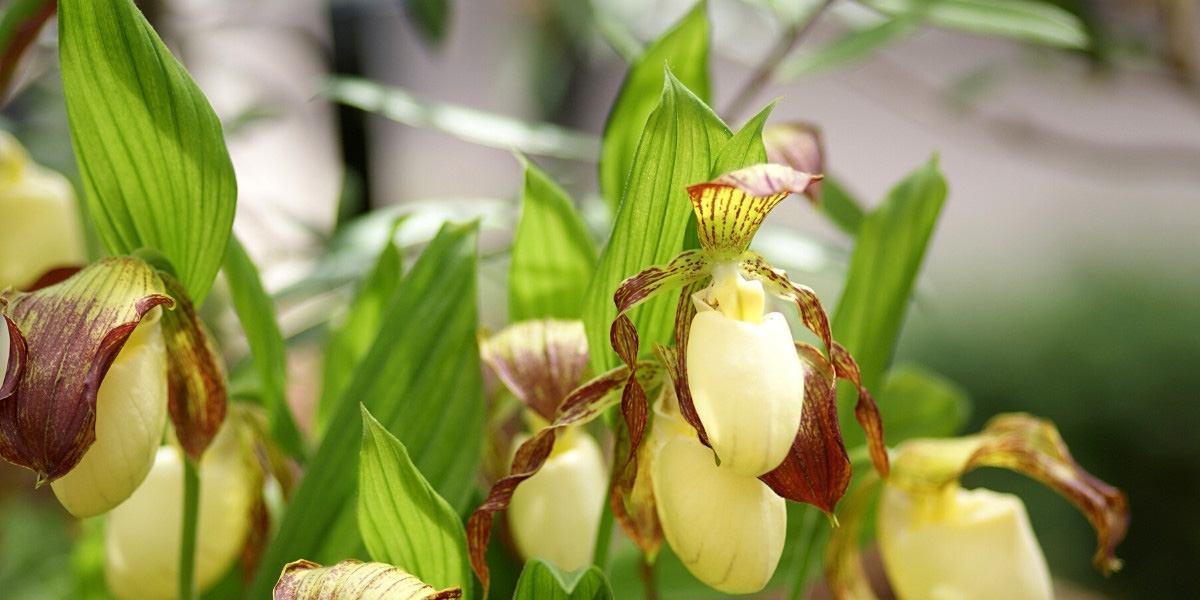

Calanthe tricarinata - Garden orchid
Calanthe tricarinata - Garden orchid
Calanthe tricarinata
Garden orchid
Lovely plant, beautiful flowers planted under a pine tree alongside ferns, fuchsias, and Venus orchid.
Catherine, 29/10/2024
Special offer!
Receive a €20 voucher for any order over €90 (excluding delivery costs, credit notes, and plastic-free options)!
1- Add your favorite plants to your cart.
2- Once you have reached €90, confirm your order (you can even choose the delivery date!).
3- As soon as your order is shipped, you will receive an email containing your voucher code, valid for 3 months (90 days).
Your voucher is unique and can only be used once, for any order with a minimum value of €20, excluding delivery costs.
Can be combined with other current offers, non-divisible and non-refundable.
Why not try an alternative variety in stock?
View all →This plant carries a 6 months recovery warranty
More information
We guarantee the quality of our plants for a full growing cycle, and will replace at our expense any plant that fails to recover under normal climatic and planting conditions.
Would this plant suit my garden?
Set up your Plantfit profile →
Description
Calanthe tricarinata is a semi-hardy perennial orchid, still rare in our gardens. It is a highly prized plant in Europe, with foliage that disappears in winter, and a flower spike composed of refined flowers with yellow-green sepals and petals, and a fringed, dark pink-copper lip. Its long green leaves form beautiful clumps over the years. Flowering occurs in spring. It should be grown in bright shade, in thick humus and in a sheltered location.
This terrestrial orchid comes directly from the mountains of Japan to the Himalayas. It is adapted to the cold and one of the hardiest species in its genus. This plant develops from tightly packed pseudobulbs around a rhizome, vaguely resembling the body of a shrimp. In spring, usually April-May it produces magnificent bicoloured flowers along 4 to 5 stems, 50 to 60 cm (20 to 24in) in height for about a month. The flower is composed of 3 sepals and 3 petals, one of which is very different, called the lip. The lip of Calanthe tricarinata is wide, deeply pleated, in a purple-pink and copper shade, marked with white at the base, while the other floral parts are yellow-green. The deciduous light green leaves are beautifully pleated, measuring 25-35 cm (10-14in) in length and 7 to 10 cm (3 to 4in) in width. The foliage starts to yellow in summer and completely disappears in winter.
This orchid of cool undergrowth likes acidic and humus-rich soil, moist in summer. It prefers the shelter of undergrowth, protected and bright, but never in direct sunlight. In regions with mild winters it will retain its foliage, while in other areas, the leaves will be damaged by frost and regenerate in early spring. The rhizomatous rootstock will slowly produce suckers to form beautiful clumps, expect to wait at least 3 years before having 4-5 inflorescences. An exceptional plant, which has the reputation of being easy to maintain in the garden. Plant Calanthe tricarinata in a sheltered location, in a bright and moist undergrowth, or even near water sources, in the company of arisaemas, ferns, or hostas.
Calanthe tricarinata - Garden orchid in pictures


Plant habit
Flowering
Foliage
Botanical data
Calanthe
tricarinata
Orchidaceae
Garden orchid
Southeast Asia
Other Calanthe
View all →Planting and care
Calanthe tricarinata likes protected environments, soils rich in humus, light, moist, and occasionally damp. The soil should never dry out in summer but should never be waterlogged in winter. In high winter humidity, the rootstock may rot. Plant it in partial shade, at the edge of large trees, with west being the best exposure. In heavy soil, add 1/3 leaf compost and 1/3 non-chalky sand, mixed with your topsoil to a depth and width of 20-25cm (8-10in). In regions with cold winters, protection is essential against cold and wet. Growing in pots or containers is possible, using a mixture of 60% ericaceous soil, 20% horticultural compost, and 20% coarse sand. Terrestrial calanthes are quite demanding plants during the growing season: applying geranium-type fertilizer at half strength every week from mid-May to mid-September will be very beneficial.
Planting period
Intended location
Care
Planting & care advice
-
, onOrder confirmed
Reply from on Promesse de fleurs
Haven't found what you were looking for?
Hardiness is the lowest winter temperature a plant can endure without suffering serious damage or even dying. However, hardiness is affected by location (a sheltered area, such as a patio), protection (winter cover) and soil type (hardiness is improved by well-drained soil).

Photo Sharing Terms & Conditions
In order to encourage gardeners to interact and share their experiences, Promesse de fleurs offers various media enabling content to be uploaded onto its Site - in particular via the ‘Photo sharing’ module.
The User agrees to refrain from:
- Posting any content that is illegal, prejudicial, insulting, racist, inciteful to hatred, revisionist, contrary to public decency, that infringes on privacy or on the privacy rights of third parties, in particular the publicity rights of persons and goods, intellectual property rights, or the right to privacy.
- Submitting content on behalf of a third party;
- Impersonate the identity of a third party and/or publish any personal information about a third party;
In general, the User undertakes to refrain from any unethical behaviour.
All Content (in particular text, comments, files, images, photos, videos, creative works, etc.), which may be subject to property or intellectual property rights, image or other private rights, shall remain the property of the User, subject to the limited rights granted by the terms of the licence granted by Promesse de fleurs as stated below. Users are at liberty to publish or not to publish such Content on the Site, notably via the ‘Photo Sharing’ facility, and accept that this Content shall be made public and freely accessible, notably on the Internet.
Users further acknowledge, undertake to have ,and guarantee that they hold all necessary rights and permissions to publish such material on the Site, in particular with regard to the legislation in force pertaining to any privacy, property, intellectual property, image, or contractual rights, or rights of any other nature. By publishing such Content on the Site, Users acknowledge accepting full liability as publishers of the Content within the meaning of the law, and grant Promesse de fleurs, free of charge, an inclusive, worldwide licence for the said Content for the entire duration of its publication, including all reproduction, representation, up/downloading, displaying, performing, transmission, and storage rights.
Users also grant permission for their name to be linked to the Content and accept that this link may not always be made available.
By engaging in posting material, Users consent to their Content becoming automatically accessible on the Internet, in particular on other sites and/or blogs and/or web pages of the Promesse de fleurs site, including in particular social pages and the Promesse de fleurs catalogue.
Users may secure the removal of entrusted content free of charge by issuing a simple request via our contact form.
The flowering period indicated on our website applies to countries and regions located in USDA zone 8 (France, the United Kingdom, Ireland, the Netherlands, etc.)
It will vary according to where you live:
- In zones 9 to 10 (Italy, Spain, Greece, etc.), flowering will occur about 2 to 4 weeks earlier.
- In zones 6 to 7 (Germany, Poland, Slovenia, and lower mountainous regions), flowering will be delayed by 2 to 3 weeks.
- In zone 5 (Central Europe, Scandinavia), blooming will be delayed by 3 to 5 weeks.
In temperate climates, pruning of spring-flowering shrubs (forsythia, spireas, etc.) should be done just after flowering.
Pruning of summer-flowering shrubs (Indian Lilac, Perovskia, etc.) can be done in winter or spring.
In cold regions as well as with frost-sensitive plants, avoid pruning too early when severe frosts may still occur.
The planting period indicated on our website applies to countries and regions located in USDA zone 8 (France, United Kingdom, Ireland, Netherlands).
It will vary according to where you live:
- In Mediterranean zones (Marseille, Madrid, Milan, etc.), autumn and winter are the best planting periods.
- In continental zones (Strasbourg, Munich, Vienna, etc.), delay planting by 2 to 3 weeks in spring and bring it forward by 2 to 4 weeks in autumn.
- In mountainous regions (the Alps, Pyrenees, Carpathians, etc.), it is best to plant in late spring (May-June) or late summer (August-September).
The harvesting period indicated on our website applies to countries and regions in USDA zone 8 (France, England, Ireland, the Netherlands).
In colder areas (Scandinavia, Poland, Austria...) fruit and vegetable harvests are likely to be delayed by 3-4 weeks.
In warmer areas (Italy, Spain, Greece, etc.), harvesting will probably take place earlier, depending on weather conditions.
The sowing periods indicated on our website apply to countries and regions within USDA Zone 8 (France, UK, Ireland, Netherlands).
In colder areas (Scandinavia, Poland, Austria...), delay any outdoor sowing by 3-4 weeks, or sow under glass.
In warmer climes (Italy, Spain, Greece, etc.), bring outdoor sowing forward by a few weeks.
















































